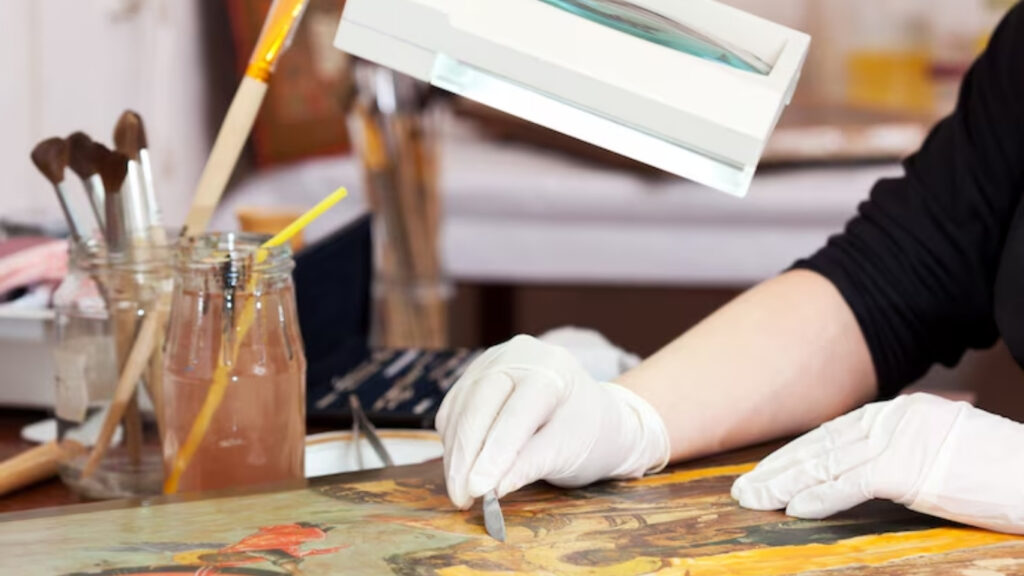Serigraphy, more commonly known as screen printing, is an artistic and industrial printing technique that has stood the test of time. Often celebrated for its bold, vibrant results and versatile application, serigraphy blends traditional craftsmanship with modern technology. From ancient stencils to Andy Warhol’s pop art, this printing method has evolved into a dynamic medium used by artists, entrepreneurs, and manufacturers alike.
In this comprehensive 3000-word article, we’ll dive deep into the world of serigraphy — tracing its historical roots, examining its processes and materials, exploring its applications in both fine art and commerce, and looking ahead at its digital future.
What is Serigraphy?
Serigraphy is a printmaking technique that involves pressing ink through a mesh screen (originally silk, now synthetic fibers) onto a surface, such as paper, fabric, or plastic. A stencil blocks off parts of the screen to create a design. Only the open areas allow ink to pass through, transferring the image.
The term “serigraphy” comes from the Latin word sericum (silk) and the Greek graphē (writing). While “screen printing” is widely used in commercial contexts, “serigraphy” often refers to the artistic application of this technique.
The Origins and History of Serigraphy
Ancient Beginnings
Screen printing’s earliest origins can be traced back over 1,000 years. Evidence suggests that stencil-based printing methods were used in:
- China (c. 960 AD): Artists used silk mesh and lacquered paper stencils to create intricate patterns on fabrics.
- Japan: Craftsmen refined these techniques using elaborate stencils and brushes to print on textiles, especially for traditional kimonos.
Though primitive compared to today’s tools, these methods laid the groundwork for the development of modern serigraphy.
Arrival in the West
Serigraphy remained largely an Asian art form until it was introduced to Europe in the late 18th century. Initially, it was used for decorative wallpaper, textiles, and signs. However, it wasn’t until the early 20th century that screen printing became widely adopted in Europe and the United States, coinciding with the development of photo-reactive chemicals.
The Artistic Revolution
The 1930s saw serigraphy being adopted by fine artists, thanks in part to the Federal Art Project during the Great Depression. It was around this time that the term “serigraph” was coined by Carl Zigrosser to distinguish artistic screen prints from commercial ones.
One of the most notable moments in the history of serigraphy was its explosion in popularity during the Pop Art movement of the 1960s. Andy Warhol’s iconic prints, such as the Marilyn Monroe series, revolutionized public perception of the medium, transforming it into a staple of contemporary art.
How Serigraphy Works: The Process Explained
The process of serigraphy involves several carefully executed steps. Though modern tools and techniques can vary, the foundational process remains largely unchanged.
1. Preparing the Screen
The screen is typically a fine mesh made from polyester or nylon stretched tightly over a wooden or aluminum frame. To create a stencil, the screen is coated with a light-sensitive emulsion.
2. Creating the Design
The desired image is printed onto a transparent film (called a film positive). This film is then placed over the emulsion-coated screen and exposed to ultraviolet (UV) light. The light hardens the emulsion wherever it’s not blocked by the design. After exposure, the unexposed emulsion is washed away, leaving a stencil of the image.
3. Setting Up the Print Surface
The surface to be printed — whether it’s fabric, paper, wood, or plastic — is placed on a flat bed beneath the screen. Precise alignment (registration) is crucial for multicolor prints.
4. Applying the Ink
Ink is poured onto the screen and pulled across using a squeegee. The ink passes through the open stencil areas onto the substrate. For multi-color designs, this step is repeated with a new screen for each color.
5. Curing and Finishing
After printing, the material is dried or heat-cured to fix the ink. Some materials may require additional steps like washing, drying, or framing.
Tools and Materials in Serigraphy
A wide range of tools and materials are essential for successful screen printing:
Screens and Frames
- Made from aluminum or wood
- Mesh counts vary depending on the detail required
Inks
- Plastisol Ink: Common in textile printing, doesn’t dry until cured
- Water-Based Ink: Eco-friendlier, softer finish
- Solvent-Based Ink: Used for printing on hard surfaces
- UV Ink: Cures instantly under UV light
Squeegees
- Different durometers (hardness levels) affect ink deposit
- Blade shapes (square, round, etc.) influence print sharpness
Emulsion and Coating Tools
- Light-sensitive emulsions enable stencil creation
- Scoop coaters ensure even emulsion layers
Drying and Curing Equipment
- Conveyor dryers, flash dryers, or heat presses for textiles
- UV curing units for certain inks
Applications of Serigraphy
Serigraphy’s versatility makes it a go-to technique across diverse fields:
1. Fine Art
Artists use serigraphy for its vibrant colors and ability to produce limited-edition prints. The tactile quality of screen prints and the ability to layer colors make it a favorite among contemporary printmakers.
2. Fashion and Textiles
T-shirts, hoodies, bags, and even luxury fabrics are screen printed for bold, lasting designs. Many brands prefer serigraphy for its quality and durability on cotton, polyester, and blends.
3. Advertising and Signage
Posters, billboards, and stickers are often created using screen printing. This method is cost-effective for bulk production and provides excellent color saturation and outdoor durability.
4. Packaging and Branding
Serigraphy is used to print logos and designs on bottles, boxes, and other packaging materials. It’s especially favored for limited-edition or premium packaging.
5. Industrial Uses
Circuit boards, solar cells, and control panels can be printed using specialized serigraphy techniques, showcasing the method’s adaptability to non-artistic fields.
Serigraphy in the Digital Age
With the rise of digital printing, you might assume that traditional methods like serigraphy are becoming obsolete. In reality, they coexist — and often complement each other.
Hybrid Printing Techniques
Many modern workshops use a hybrid model: screen printing for base layers and digital printing for detail or personalization. This approach balances speed, quality, and customization.
Automation and Robotics
Automated screen printing machines can produce thousands of prints per hour. Robotic arms, smart curing systems, and software-controlled registration are making industrial serigraphy more efficient than ever.
Eco-Friendly Innovations
As environmental awareness grows, many studios are shifting toward:
- Water-based and soy-based inks
- Biodegradable emulsions
- Solar-powered drying units
Sustainability is becoming a central theme in modern serigraphy.
Famous Artists and Iconic Serigraphs
Some of the most renowned artists in modern history have contributed to the popularity and prestige of serigraphy:
Andy Warhol
- Marilyn Monroe and Campbell’s Soup Cans
- Defined the Pop Art movement using screen printing
Robert Rauschenberg
- Blended photography and screen printing in mixed media works
Sister Mary Corita Kent
- Known for colorful, socially conscious serigraphs
Shepard Fairey
- Creator of the OBEY brand and the iconic Hope poster of Barack Obama
These artists demonstrate that serigraphy is not merely a mechanical process but a dynamic form of creative expression.
Pros and Cons of Serigraphy
Pros
- Vivid, saturated colors
- Long-lasting results
- Cost-effective for large runs
- Works on diverse materials
Cons
- Labor-intensive setup
- Not economical for short runs
- Requires considerable workspace
- Multi-color designs need multiple screens
Learning Serigraphy: Resources and Tips
Whether you’re a hobbyist or aspiring professional, there are numerous resources available:
Online Courses
- Skillshare, Domestika, and Udemy offer beginner to advanced classes
Books
- Print Liberation by Jamie Dillon & Nick Paparone
- Screen Printing Today by Andy MacDougall
Workshops and Studios
- Many art centers and colleges offer serigraphy workshops
- Maker spaces often have communal screen printing labs
Tips for Beginners
- Start with one-color designs
- Practice consistent squeegee pressure
- Clean your screens immediately after use
- Keep a detailed log of ink types, mesh counts, and curing times
The Future of Serigraphy
While digital printing offers unparalleled convenience, serigraphy holds a unique appeal in both artistic and commercial contexts. Innovations in materials and automation continue to enhance its practicality, while a global community of screen printers and artists keeps the spirit of the craft alive.
From fashion to fine art, from DIY zines to industrial design, serigraphy thrives as a versatile, vibrant, and visually arresting method of expression. Its tactile charm and enduring presence ensure that screen printing — far from fading — continues to evolve, surprise, and inspire.
Conclusion: Serigraphy
Serigraphy is much more than a printing technique — it’s a crossroad of history, artistry, and innovation. Whether it’s being used to craft a striking pop art masterpiece or mass-produce custom T-shirts, its power lies in its blend of tradition and adaptability.
As we look to the future, serigraphy remains a testament to the enduring power of hands-on creativity. Whether you’re an artist, entrepreneur, or curious creator, diving into serigraphy is not just a skill — it’s an invitation to become part of a vibrant, global tradition.
FAQs: Serigraphy
q. What is the difference between serigraphy and screen printing?
A. The terms serigraphy and screen printing refer to the same printing technique, but they are used in different contexts. Serigraphy typically refers to the artistic application of the method, often involving limited-edition prints or fine art. Screen printing is more commonly used for commercial and industrial purposes, such as printing on T-shirts or promotional materials.
q. Can serigraphy be done at home, or does it require professional equipment?
A. Yes, serigraphy can absolutely be done at home. Many artists and hobbyists set up small screen printing studios using affordable DIY kits. Essential tools include a screen, squeegee, emulsion, ink, and a light source for exposing stencils. However, more advanced equipment is needed for large-scale or multicolor prints.
q. What types of materials can be printed on using serigraphy?
A. Serigraphy is extremely versatile and can be used on a wide range of materials, including:
- Fabric (e.g., T-shirts, tote bags)
- Paper and cardstock
- Wood
- Plastic
- Glass
- Metal
The key is selecting the right type of ink for each substrate.
q. Is serigraphy environmentally friendly?
A. Traditional serigraphy can involve chemicals and inks that are harmful to the environment. However, modern eco-friendly practices are becoming more common. These include using water-based or soy-based inks, biodegradable emulsions, and proper waste disposal methods. Sustainable screen printing is now a growing trend in the industry.
q. How long does a serigraph print last?
A. A properly made serigraph print is extremely durable. On fabric, screen-printed designs can withstand dozens of washes without fading if heat-cured correctly. On paper or other media, serigraphs can last for decades, especially when stored or displayed in proper conditions (away from moisture, direct sunlight, etc.).






